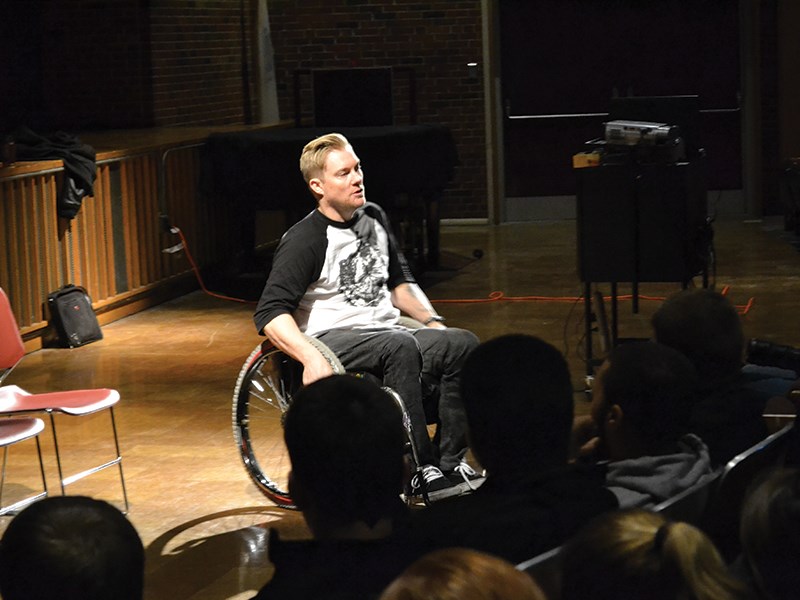Receiving a phone call and finding out their son or daughter has been in an accident is the worst nightmare for any parent. In 2000, the phone rang for Kevin Brooks’ and his best friend’s parents.
The two had left a party with Brooks driving drunk and distracted. It proved to be a destructive decision that led to an accident.
Brooks survived, but was paralyzed from the chest down, and his friend was killed. His life, and those of his parents and best friend’s family, would be forever damaged. Now Brooks tells his story as a motivational speaker throughout North America, particularly to high-school students.
“It’s intense,” said Brooks. “I don’t hold back. It’s real.”
The reality close to home, according to Powell River Fire Rescue chief Terry Peters, is “we’ve had some unfortunate incidents with youth in town.”
The fire department is one of approximately 20 emergency and first-responder detachments, public health services, social agencies, individuals and businesses that will participate in Prevention of Alcohol and Risk Behaviours Trauma in Youth Program (PARTY) on February 20, 21 and 22 at Brooks Secondary School.
Powell River Mental Health and Addiction Services was a driving force behind bringing PARTY, now in its sixth year, to Powell River.
“It was the same year we were seeing youth who were out causing havoc in the community,” said Vancouver Coastal Health addiction prevention clinician Rachel Hyrniuk.
Although she has no statistics from Powell River General Hospital’s emergency room, comments from physicians indicate the program works, said Hyrniuk.
Six years of data has been accumulated through surveys of students.
“Across the board,” said Hyrniuk, “we always get, ‘useful.’”
According to Peters, students are shown the reality of making wrong decisions, which can result in tragic life and death consequences. Students are taken through every step of a realistic accident scene, including extraction, transport to hospital, the emergency room and even the morgue.
Drinking and driving is no longer the singular focus of the PARTY program. Accidents caused by distracted driving are increasing among youth.
“Before, kids who were aged 18 to 25, it was drinking and driving that was killing them and having the biggest impact on their lives and their parents,” said Peters. “Now it’s texting and driving. Distracted driving is becoming a greater cause.”
Firefighter Rocky Swanson likens today’s awareness campaigns, efforts and penalties to discourage drinking and driving, and now texting and driving, to years ago when wearing a seatbelt became a law in Canada.
“35 years ago, I was a kid out at Kelly Creek School and they had a program called Buckle Up,” said Swanson. “I remember telling my parents to buckle up, but they were totally opposed to seat belts. Now everybody wears one.”
Speaking at an assembly of grade 11 students on Monday, February 27, Brooks will attempt to drive the smart choices home. When in front of a young audience, he said he can almost spot the kids who are the risk-takers.
“It could be just a swagger, or just the way they present themselves,” he said. “They’re in the back with five guys sitting together.”
It takes one to know one, he said.
“I was the risk-taker, the hardest partier, the rowdiest and the guy who got in the most trouble,” said Brooks. “I was a little terror and I thought I was invincible.”
Brooks said he cannot get through to some students, including one that he remembers in particular.
“My phone rang and it was a student who had seen me speak that had crashed and his friend died,” said Brooks. “I don’t think the student was paralyzed, but emotionally he was absolutely devastated. It broke my heart. I remember that kid being so distraught and saying, ‘I should have listened, I should have listened.’ I really don’t want to have that call again from someone who could have learned from me, and then decided not to and put themselves or others through something like this.”



